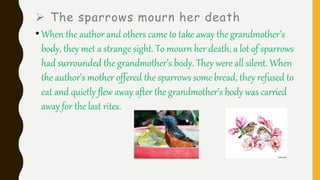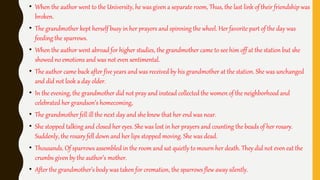The portrait of a lady
- 1. MADE BY JYOTI KUMARI CL ASS 11 D ROLL NO 18
- 2. ABOUT THE AUTHOR • Author Name : Khushwant Singh • Born : 2 February 1915, Hadali, Pakistan • Died : 20 March 2014, Sujan Singh Park, Delhi • Spouse : Kawal Malik (m. 1939–2001) • Education : GCU, Panjab University, King’s College London, The Dickson Poon School of Law, St Stephen’s College • Awards : Padma Bhushan, Padma Vibhushan, Punjab Rattan Award
- 3. • The Portrait of a Lady’ is part of an autobiography by Khushwant Singh. In this story, the author draws a pen portrait of his grandmother. He beautifully unfolds their relationship and how it undergoes several changes. In other words, the story is a loving tribute from a grandson to his grandmother. The story gives a picture of human relationships. It is a realistic account of how the grandparents give all their time, attention and love to their grandchildren.
- 4. • Grandmother: Khushwant Singh’s grandmother is described as an extremely religious person. She was a very kind lady. She was short, fat and slightly bent. Her face was wrinkled and she was always dressed in spotless white clothes. In the village she took care of all the needs of the author when he was a child. Khushwant Singh, the author: He recounts his childhood days and his relationship with his grandmother.
- 5. • The Author Remembers his Grandmother and Grandfather • The author recalls his grandmother as a very old lady. For the twenty years that the author had known his grandmother, he had found her old and wrinkled. • It was hard for him to believe that she had once been young and pretty and she had a husband. Khushwant Singh’s grandfather’s portrait hung on the wall of the drawing room. He wore a big turban. His clothes were loose. He looked at least a hundred years old. Looking at his portrait, one could not imagine him in his youth with his wife and children.
- 6. The author’s grandmother • The thought of the grandmother being young and pretty was almost revolting to him. She was short, fat and slightly bent in stature. Her face was a crisscross of wrinkles. Her silvery white hair was scattered over her wrinkled face. • The author remembered her hobbling around the house in spotless white clothes with one hand resting on her waist to balance her stoop and the other hand busy counting the beads of her rosary. Her lips constantly moved in inaudible prayer. • To the author, she could never have been pretty, but she reflected a divine beauty. She was like the winter landscape in the mountains.
- 7. The author’s childhood with his grand mother • The author and his grandmother were good friends. His parents left him to stay with her when they shifted to the city. In the village, his grandmother took care of all his needs. She was quite active and agile. She used to wake him up in the morning and get him ready for school. She said her morning prayers in a sing-song manner while she bathed and dressed him in the hope that her grandson would learn them by heart. The author listened to the prayers because he loved her voice, but never bothered to learn them. • Then she would fetch his wooden slate which, she had already washed, and plastered it with yellow chalk. She would take an earthen inkpot and a reed pen and tie them in a bundle and hand it to author. After having a thick, stale chapatti with a little butter and sugar spread on it for breakfast, they used to leave for school. The author’s grandmother always accompanied him to the school as it was attached to the temple.
- 8. The author at school • The priest taught children the alphabet and the morning prayer. The children sat in two rows in the verandah. They would sing the alphabet or the prayer in a chorus. While the author learnt his lessons at school, the grandmother would read scriptures in the adjoining temple. On their way back, they would feed stale chapattis to the dogs. The turning point in the relationship of grandmother and the author • The turning point came in their relationship when they moved to the city to stay with Khushwant Singh’s parents. In the city, the author went to an English school in a motor bus. The grandmother could not accompany him to the school. As there were no dogs in the streets, the grandmother took to feeding the sparrows. • As the years rolled by, they saw less of each other. In spite of her immense interest in his studies, she could not help him in his lessons as he was learning English, the law of gravity, Archimedes’ principle and many more such things which she could not understand, and this made her unhappy. Sometimes she would ask him what the teacher had taught him.
- 9. Grandmother distressed and disturbed • Grandmother didn’t believe in the things taught at the English school and was distressed to learn that there was no teaching about God and the scriptures in the school. • Moreover, she was very disturbed at the idea of music lessons being given at the English school. To her, music had lewd associations and she considered music to be unsuitable for gentle folk. The common link of friendship gets snapped • The common link of friendship between the author and the grandmother was broken when the author went to the University and was given a room of his own. The grandmother accepted her loneliness and rarely spoke to anyone. All day long, she sat spinning the wheel and reciting her prayers. • Only in the afternoon she relaxed for a while to feed the sparrows. They perched on her shoulders and some even on her head but she never shooed them away. It used to be the happiest half-hour of the day for her.
- 10. The author leaves for higher studies • The author decided to go abroad for higher studies for five years. He was sure that his grandmother would be upset at his departure, but she was not even sentimental. She came to the railway station to see him off. She showed no emotion. She was absorbed in praying and counting the beads of her rosary. Silently she kissed his forehead. The author thought that perhaps it was the last sign of physical contact between them
- 11. The grandmother celebrates the author’s return and falls sick • After five years, the author found his grandmother at the station when he returned. She held him in her arms. He found her more religious and more self-contained. He could hear her reciting prayers. Even that day, the happiest moment for her was feeding the sparrows herself. However, something strange happened to her in the evening. • For the first time ever, she did not pray. Instead, she collected the women of the neigh bourhood, got an old drum and started to sing songs of the homecoming of warriors. They tried to persuade her to stop to avoid overstraining herself. But she didn’t listen. She fell ill the next morning.
- 12. Grandmother’s death • The grandmother was diagnosed with a mild fever by the doctor but she insisted that her end was near. She told everyone that she did not want to talk to anyone and would rather spend her last moments praying. She ignored everyone’s protests and started counting the beads in her rosary while praying. • After a short while, the author noticed that his grandmother’s lips stopped moving and the rosary fell from her lifeless fingers. She died a peaceful death. She was covered with a red shawl.
- 13. The sparrows mourn her death •When the author and others came to take away the grandmother’s body, they met a strange sight. To mourn her death, a lot of sparrows had surrounded the grandmother’s body. They were all silent. When the author’s mother offered the sparrows some bread, they refused to eat and quietly flew away after the grandmother’s body was carried away for the last rites.
- 14. The portrait of A lady chapter highlights • When the author, Khushwant Singh, was a little child, his parents left him in the village with his grandmother and went to live in the city. • The author’s grandmother was an old lady. She was very religious. The author shared a very close bond with his grandmother. They became very good friends. • The grandmother woke him up, dressed him and accompanied him to school. The school was attached to the temple. • While the author was at school, the grandmother used to read the scriptures in the temple. • When the author’s parents were well-settled, he and his grandmother also went to the city. It proved a turning point in their friendship. • In the city, Khushwant Singh attended an English school and travelled in a motor bus. He learnt English words and topics of Western Science. • The grandmother could no longer accompany him to his school nor help him in his studies. However, they shared the same room.
- 15. • When the author went to the University, he was given a separate room, Thus, the last link of their friendship was broken. • The grandmother kept herself busy in her prayers and spinning the wheel. Her favorite part of the day was feeding the sparrows. • When the author went abroad for higher studies, the grandmother came to see him off at the station but she showed no emotions and was not even sentimental. • The author came back after five years and was received by his grandmother at the station. She was unchanged and did not look a day older. • In the evening, the grandmother did not pray and instead collected the women of the neighborhood and celebrated her grandson’s homecoming, • The grandmother fell ill the next day and she knew that her end was near. • She stopped talking and closed her eyes. She was lost in her prayers and counting the beads of her rosary. Suddenly, the rosary fell down and her lips stopped moving. She was dead. • Thousands. Of sparrows assembled in the room and sat quietly to mourn her death. They did not even eat the crumbs given by the author’s mother. • After the grandmother’s body was taken for cremation, the sparrows flew away silently.
- 16. Word meanings • portrait – true picture • mantelpiece – shelf above a fireplace • absurd – ridiculous • fables of the prophets – stories of the Sikh Gurus • hobbled – walked with difficulty • stoop – bent body due to old age • telling the beads – counting the beads while chanting prayers • rosary – a string of beads used for counting prayers as they are chanted • puckered – wrinkled • inaudible – which cannot be heard • serenity – calm and peaceful
- 17. • monotonous – unchanging • stale – not fresh • in a chorus – together • courtyard – an open space just outside the house • lewd – indecent • harlots – prostitutes • bedlam – confusion • thumped – beat hard • dilapidated – falling to pieces • pallor – pale coloring of the face • shroud – a piece of cloth used to cover a dead body before cremation • crude – made in a simple manner • scattered – lying here and there • took no notice of – did not care
















